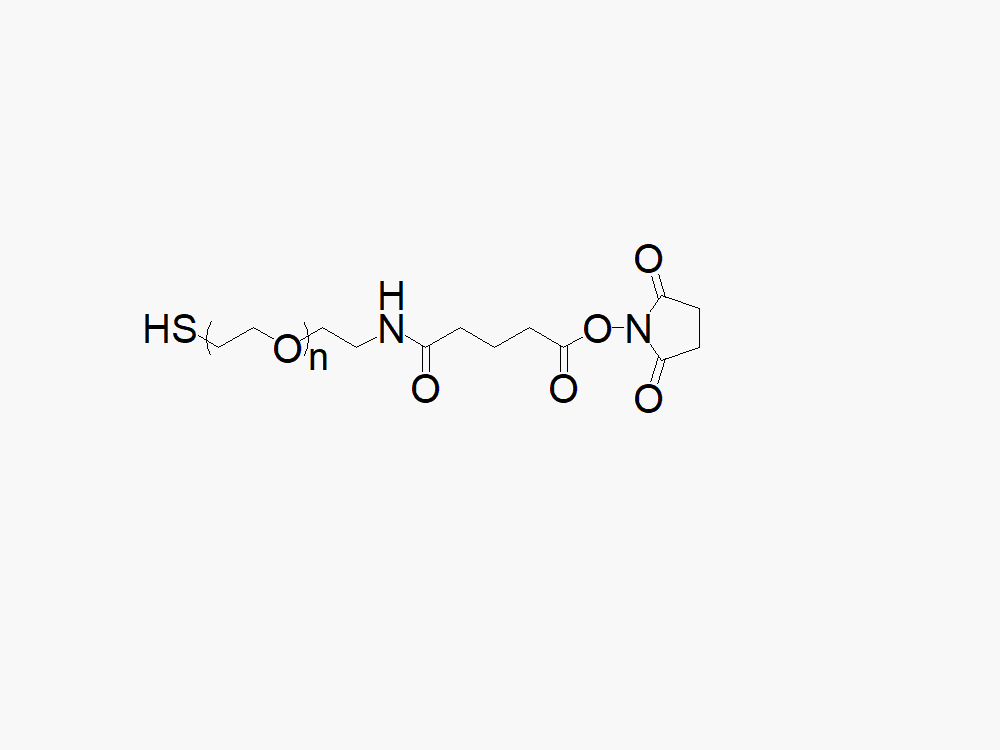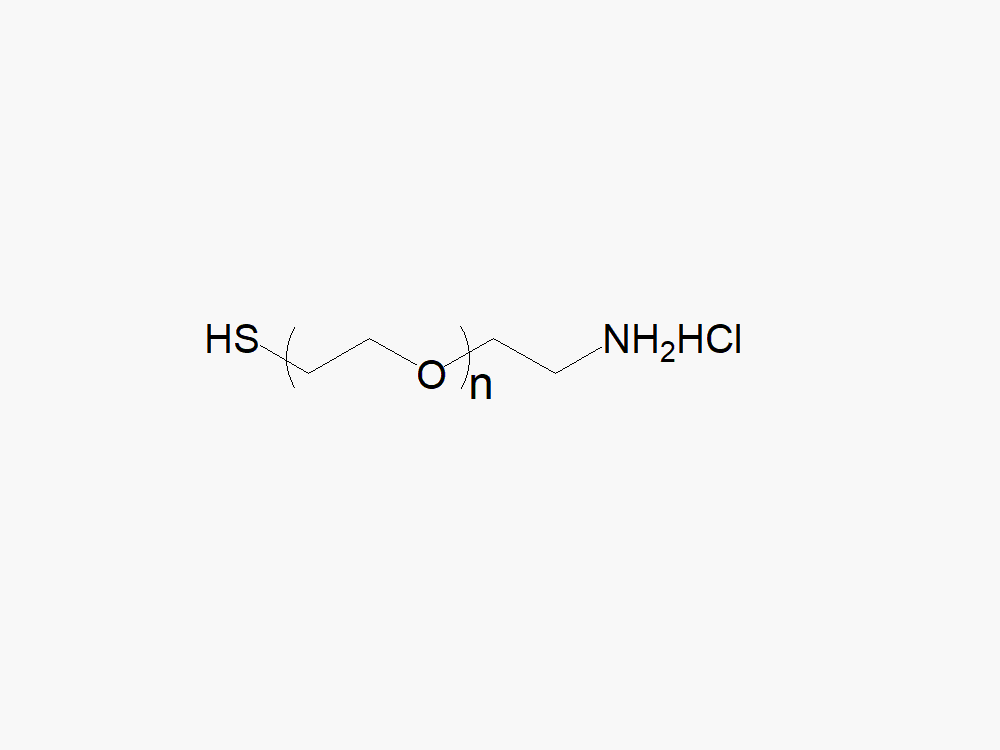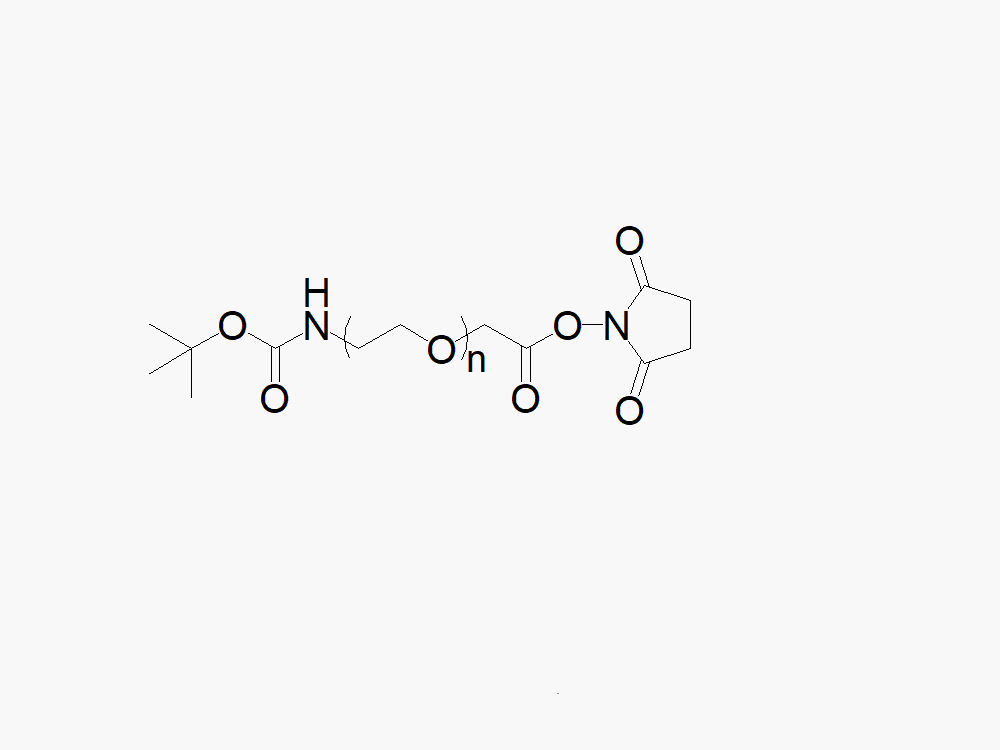产品中心
联系我们
销售专用:
地址:北京市海淀区西小口路66号中关村东升科技园C-1楼三层

Acrylate PEG Succinimidyl Carboxymethyl Ester
产品代号:
ACLT-PEG-SCM
产品纯度:
≥ 90%
包装规格:
1g, 10g, 100g等(特殊包装需收取分装费用)
分子量:
2000 Da,3500 Da, 5000 Da, 7500 Da等
关键词:
所属分类:
科研客户小批量一键采购地址(小于5克)
- 产品描述
- 参考文献
-
必赢网址bwi437科技提供高品质丙烯酸酯聚乙二醇琥珀酰亚胺羧甲基酯,产品取代率>90%。
必赢网址bwi437科技生产的异双功能丙烯酸PEG琥珀酰亚胺基羧甲基酯产品通常用作两种不同化学物质的交联剂或间隔物。此异功能PEG衍生物中的PEG部分可提供水溶性、生物相容性及柔性。此产品专门应用于抗体偶联药物(ADC’s)的开发。
必赢网址bwi437科技提供ACLT-PEG-SCM分子量2000 Da,3500 Da, 5000 Da, 7500 Da的产品1克和10克包装。
必赢网址bwi437科技提供分装服务,需要收取分装费用,如果您需要分装为其他规格请与我们联系。
必赢网址bwi437科技同时提供其他分子量的ACLT-PEG-SCM衍生物产品,如你需要请与我司sales@jenkem.com联系。
必赢网址bwi437科技提供大批量生产产品及GMP级别产品,如需报价请与我们联系。
-
References:
1. Post, A., et al., Elucidation of Endothelial Cell Hemostatic Regulation with Integrin-Targeting Hydrogels, Annals of biomedical engineering, 2019.
2. Shih, T.Y., et al., Injectable, Tough Alginate Cryogels as Cancer Vaccines, Advanced healthcare materials, 2018, p.1701469.
3. Stukel, J.M., et al., The interplay of peptide affinity and scaffold stiffness on neuronal differentiation of neural stem cells. Biomedical Materials, 2018, 13(2), p.024102.
4. Post, A., et al., Introduction of sacrificial bonds to hydrogels to increase defect tolerance during suturing of multilayer vascular grafts, Acta Biomaterialia 2018, V. 69, p. 313-322.
5. Lauridsen, H.M., et al., Ultrathin and elastic hydrogels regulate human neutrophil extravasation across endothelial-pericyte bilayers, PloS one, 2017, 12(2).
6. Slaughter, G., et al., Fabrication of palladium nanowire array electrode for biofuel cell application, Microelectronic Engineering, 2016, 149, P. 92-96.
7. Wang, Y., et al., Electroresponsive Nanoparticles Improve Antiseizure Effect of Phenytoin in Generalized Tonic-Clonic Seizures. Neurotherapeutics, 2016, 1-1.
8. Ho-Joon Lee, et al., Poly(ethylene glycol) diacrylate/hyaluronic acid semi-interpenetrating network compositions for 3-D cell spreading and migration, Acta Biomaterialia, 2015, 14, p: 43-52.
9. Parmar, P. A., et al., Collagen-mimetic peptide-modifiable hydrogels for articular cartilage regeneration, Biomaterials, 2015, 54: 213-225.
10. Hoffman, M.D., et al., Emulating native periosteum cell population and subsequent paracrine factor production to promote tissue engineered periosteum-mediated allograft healing, Biomaterials, 2015, 52, P. 426-440.
11. Rich, M.H., et al., Water–Hydrogel Binding Affinity Modulates Freeze-Drying-Induced Micropore Architecture and Skeletal Myotube Formation, Biomacromolecules, 2015, 16 (8), 2255-2264.
12. Bae, S., et al., Cell-Mediated Dexamethasone Release from Semi-IPNs Stimulates Osteogenic Differentiation of Encapsulated Mesenchymal Stem Cells, Biomacromolecules, 2015, 16 (9), 2757-2765.
13. Shkumatov, A., et al., Matrix stiffness-modulated proliferation and secretory function of the airway smooth muscle cells, American Journal of Physiology – Lung Cellular and Molecular Physiology, 2015, 308:11, L1125-L1135.
14. Mahadik, B.P., et al., The use of covalently immobilized stem cell factor to selectively affect hematopoietic stem cell activity within a gelatin hydrogel, Biomaterials, 2015, 67, P. 297-307.
15. Atanu, S., et al., Capillary Channel Polymer Fiber-Based Scaffolds for Neural Regeneration, 2015.
16. Reis, L.A., et al., A Peptide Modified Hydrogel Therapy for Acute Myocardial Infarction, 2015.
17. Kim, H. D., et al., Extracellular-Matrix-Based and Arg-Gly-Asp–Modified Photopolymerizing Hydrogels for Cartilage Tissue Engineering, Tissue Engineering Part A, 2015, 21(3-4): 757-766.
18. Bencherif, S.A., et al., Injectable cryogel-based whole-cell cancer vaccines, Nature Communications, 2015, 6: 7556.
19. Dang, L.T.H., et al., Inhibition of apoptosis in human induced pluripotent stem cells during expansion in a defined culture using angiopoietin-1 derived peptide QHREDGS, Biomaterials, 2014, 35(27): p. 7786-7799.
20. Hoffman, M.D., et al., Degradable hydrogels for spatiotemporal control of mesenchymal stem cells localized at decellularized bone allografts. Acta Biomaterialia, 2014, 10(8): p. 3431-3441.
21. Gonzalez, A. L., et al., Integrin-driven monocyte to dendritic cell conversion in modified extracorporeal photochemotherapy, Clin Exp Immunol, 2014, 175(3): 449-457.
22. Slaughter, G., et al., Fabrication of Enzymatic Glucose Hydrogel Biosensor Based on Hydrothermally Grown ZnO Nanoclusters, Sensors Journal, IEEE, 2014, 14:5, pp.1573-1576.
23. Feric, N.T., et al., Angiopoietin-1 peptide QHREDGS promotes osteoblast differentiation, bone matrix deposition and mineralization on biomedical materials, Biomater. Sci., 2014, 2, 1384-1398.
24. Shkumatov, A., et al., Matrix Rigidity-Modulated Cardiovascular Organoid Formation from Embryoid Bodies, PLoS ONE, 2014, 9(4): e94764.
25. Luong, P.T., et al, Drying and storage effects on poly(ethylene glycol) hydrogel mechanical properties and bioactivity. J Biomed Mater Res Part A, 2014, 102A, 3066–3076.
26. Kim, J., et al., Cell-Friendly Inverse Opal-Like Hydrogels for a Spatially Separated Co-Culture System. Macromol. Rapid Commun., 2014, 35: 1578–1586.
27. Chan, V., 3D Printing of Biological Machines for Biology and Medicine, University of Illinois at Urbana-Champaign, 2013.
28. Qi, H., et al., DNA-directed self-assembly of shape-controlled hydrogels. Nat Commun, 2013, 4.
29. Browning, M.B., et al., Bioactive Hydrogels with Enhanced Initial and Sustained Cell Interactions, Biomacromolecules, 2013, 14(7) p: 2225–2233
30. Hoffman, M. D., et al., Agonism of Wnt-beta-catenin signalling promotes mesenchymal stem cell (MSC) expansion, J Tissue Eng Regen Med, 2013.
31. Hoffman, M. D., et al., The effect of mesenchymal stem cells delivered via hydrogel-based tissue engineered periosteum on bone allograft healing. Biomaterials, 2013, 34.35: 8887-8898.
32. Reid, B., et al., Enhanced tissue production through redox control in stem cell-laden hydrogels, Tissue Engineering Part A, 2013, 19.17-18, 2014-2023.
33. Zhou, W., et al., Comparison of neurite growth in three dimensional natural and synthetic hydrogels. Journal of Biomaterials Science, Polymer Edition, 2013, 24.3: 301-314.
34. Scott, M.A., Ultra-rapid 2-D and 3-D laser microprinting of proteins. Diss. Massachusetts Institute of Technology, 2013.
35. Browning, M.B., et al., Development of a Biostable Replacement for PEGDA Hydrogels, Biomacromolecules, 2012, 13(3), p: 779–786.
36. Wang, X., et al., Endothelial cell adhesion and proliferation to PEGylated polymers with covalently linked RGD peptides, J Biomed Mater Res A, 2012, 100(3): 794-801.
37. Browning, M.B., et al., Multilayer vascular grafts based on collagen-mimetic proteins, Acta Biomaterialia, 2012, 8(3), p: 1010-1021.
38. Chen, A.A., at al., Humanized mice with ectopic artificial liver tissues, PNAS, 2011, 108(29), p: 11842–11847.
39. Cao Y., et al., A peptidomimetic inhibitor of matrix metalloproteinases containing a tetherable linker group, J Biomed Mater Res A., 2011, 96(4):663-72.
40. Xu, X., et al., Shape Memory RGD-Containing Networks: Synthesis, Characterization, and Application in Cell Culture. Macromol. Symp., 2011, 309-310: 162–172.
41. Yang, L., et al., Design considerations in the use of interdigitated microsensor electrode arrays (IMEs) for impedimetric characterization of biomimetic hydrogels, Biomedical Microdevices, 2011, 13:2, pp 279-289.
42. Zorlutuna, P., et al., Stereolithography-Based Hydrogel Microenvironments to Examine Cellular Interactions, Adv. Funct. Mater., 2011, 21: 3642–3651.
43. Justin, G., et al., Electroconductive Blends of Poly(HEMA-co-PEGMA-co-HMMAco-SPMA) and Poly(Py- co-PyBA): In Vitro Biocompatibility, Journal of Bioactive and Compatible Polymers, 2010, 25: 121-140.
44. Cosgriff-Hernandez, E., et al., Bioactive hydrogels based on Designer Collagens, Acta Biomaterialia, 2010, 6(10), p: 3969-3977.
45. Yang, X., et al., Multifunctional Stable and pH-Responsive Polymer Vesicles Formed by Heterofunctional Triblock Copolymer for Targeted Anticancer Drug Delivery and Ultrasensitive MR Imaging, ACS Nano, 2010, 4(11) p: 6805–6817.
46. Reis, L.G., et al., Modification of Hydrogel Scaffolds for the Modulation of Corneal Epithelial Cell Responses, 26th Southern Biomedical Engineering Conference SBEC, 2010, 32, pp 175-179.
47. Chan, V., et al., Three-dimensional photopatterning of hydrogels using stereolithography for long-term cell encapsulation, Lab Chip, 2010, 10, 2062-2070.
48. He, J., et al., Rapid Generation of Biologically Relevant Hydrogels Containing Long-Range Chemical Gradients, Adv. Funct. Mater., 2010, 20: 131–137.
49. Justin, G., et al., Characterization of Electroconductive Blends of Poly(HEMA-co-PEGMA-co-HMMA-co-SPMA) and Poly(Py-co-PyBA), Biomacromolecules, 2009, 10 (9), 2539-2549.
50. Boztas, A.O., et al., Immobilization and Release of the Redox Mediator Ferrocene Monocarboxylic Acid from within Cross-Linked p(HEMA-co-PEGMA-co-HMMA) Hydrogels, Biomacromolecules, 2009, 10(8) p: 2135–2143.
51. Justin, G., et al., Bioactive Hydrogel Layers on Microdisk Electrode Arrays: Cyclic Voltammetry Experiments and Simulations. Electroanalysis, 2009, 21: 1125–1134.
52. Rahman, A., et al., Bioactive Hydrogel Layers on Microdisk Electrode Arrays: Impedimetric Characterization and Equivalent Circuit Modeling. Electroanalysis, 2009, 21: 1135–1144.
53. Justin, G., et al., Biomimetic hydrogels for biosensor implant biocompatibility: electrochemical characterization using micro-disc electrode arrays (MDEAs), Biomedical Microdevices, 2009, 11:1, pp 103-115.
54. Ghuman, H., et al., ECM hydrogel improves the delivery of PEG microsphere-encapsulated neural stem cells and endothelial cells into tissue cavities caused by stroke, Brain Research Bulletin, 2021, V. 168, P. 120-137.
55.Li, X, et al., Holographic Display-Based Control for High-Accuracy Photolithography of Cellular Micro-Scaffold with Heterogeneous Architecture. IEEE/ASME Transactions on Mechatronics. 2021
56.Li, X, et al., Automated Fabrication of the High-Fidelity Cellular Micro-Scaffold Through Proportion-Corrective Control of the Photocuring Process. IEEE Robotics and Automation Letters. 2021, 6(2):849-54.
57.Nam, K, et al., Anisotropically Functionalized Aptamer-DNA Nanostructures for Enhanced Cell Proliferation and Target-Specific Adhesion in 3D Cell Cultures. Biomacromolecules. 2021.
58.Rezaeeyazdi, M., et al., Engineering hyaluronic acid-based cryogels for CD44-mediated breast tumor reconstruction, Materials Today Bio, 2022, p.100207.
59.Liu, Z., et al., Modulated integrin signaling receptors of stem cells via ultra-soft hydrogel for promoting angiogenesis, Composites Part B: Engineering, 2022, 234.
60.Colombani, T., et al., Hypoxia-inducing cryogels uncover key cancer-immune cell interactions in an oxygen-deficient tumor microenvironment, Bioactive Materials, 29, 2023.
产品询价






